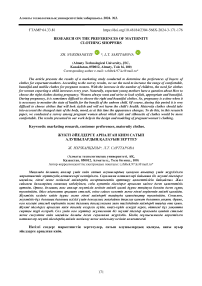Research on the preferences of maternity clothing shoppers
Автор: Nurzhankyzy Zh., Sarttarova L.T.
Журнал: Вестник Алматинского технологического университета @vestnik-atu
Рубрика: Технология текстиля и одежды, дизайн
Статья в выпуске: 3 (145), 2024 года.
Бесплатный доступ
The article presents the results of a marketing study conducted to determine the preferences of buyers of clothes for expectant mothers. According to the survey results, we see the need to increase the range of comfortable, beautiful and mobile clothes for pregnant women. With the increase in the number of children, the need for clothes for women expecting a child increases every year. Naturally, expectant young mothers have a question about How to choose the right clothes during pregnancy. Women always want and strive to look stylish, appropriate and beautiful. During pregnancy, it is sometimes difficult to choose the right and beautiful clothes. So, pregnancy is a time when it is necessary to monitor the state of health for the benefit of the unborn child. Of course, during this period it is very difficult to choose clothes that will look stylish and will not harm the child's health. Maternity clothes should take into account the changed state of the body, mood, as at this time the appearance changes. To do this, in this research paper, we conducted a survey among pregnant women about which style and silhouette of clothes would be more comfortable. The results presented in our work help in the design and modeling of pregnant women's clothing.
Marketing research, customer preferences, maternity clothes
Короткий адрес: https://sciup.org/140307009
IDR: 140307009 | DOI: 10.48184/2304-568X-2024-3-171-176
Текст научной статьи Research on the preferences of maternity clothing shoppers
ҒТАМР 64.33.81
It is important to increase the pace of preparation and carry out work to enhance marketing efforts in order to introduce a maternity clothing assortment that is adapted to market demand into overall production. The production and formation of an optimal (effective) assortment of clothing for pregnant women must be organized in a way that is affordable and harmless for stakeholders (consumers and manufacturers).
In order to effectively solve these tasks, according to previous studies by L. M. Tukhbatullina, L. N. Andreeva, M. A. Suteeva, M. S. Korgambekov, men's suits, children's clothing suitable for the conditions of Central Asia, outerwear for women, light clothing for young people, and clothing for pregnant women have been developed [1, 5, 14].
Extensive research is currently being conducted to develop an optimal and efficient wardrobe design.
The uniqueness and diversity of maternity clothing require further development and improvement based on marketing research of the consumer market. This calls for shaping the development process around the specific needs of pregnant women and the variety of situations in which they will wear these garments.
Materials and research methods
The marketing research method was conducted through a survey in the form of a Google form. The characteristics of the clothing users were determined based on the results of the research.
The number of respondents who participated in the survey was 30. The participants were divided into three age groups: the youngest, aged 17 to 23; the middle group, aged 23 to 29; and the oldest, over 29 (Figure 1) [2].
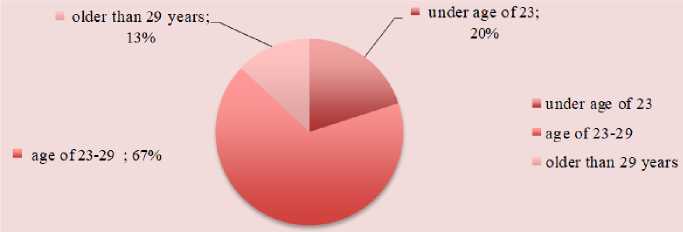
Figure 1. Diagram of the age composition of the surveyed women.
More than half of the surveyed women prefer clothing in bright and vivid colors, while the rest find it difficult to find such distinctive clothing in stores. When purchasing clothing, women primarily focus on comfort and functionality (63%) and aesthetics (20%), followed by price (9%) and the type of fabric used. This situation is primarily explained by the priority given to functional requirements of clothing. Additionally, it highlights a notable shortage of such items in those market segments. Thus, consumers are willing to pay several times more than the actual value for these items [4].
In the analysis of the consumer's clothes, it was shown that the sets that the consumer is most interested in are: blouse and jacket matching with pants (26%), overalls (24%), sundresses (23%), dresses (21%), and skirts are the least used (6%).
Analyzing the responses to the question about preferred styles, a similar distribution pattern can be observed across all age groups: the majority of women believe that classic style is most harmonious during pregnancy. As women age, the proportion adhering to this view increases to 50%, while the younger age groups also show an increase up to 50%. All age groups equally support the sporty style (32%, 34%, 32%) [5]. Approximately 12% of women respect fashion trends and believe that romantic style items should be included in their wardrobe. Compared to older age groups, the romantic style is more widely embraced by the middle and younger age groups. Between 3% and 7% of women believe that pregnancy should not necessitate a change in personal style and prefer to wear very fashionable, avant-garde items. The percentage of such women remains consistent across all age groups. Figure 2 shows the distribution diagram of responses regarding clothing styles [6].
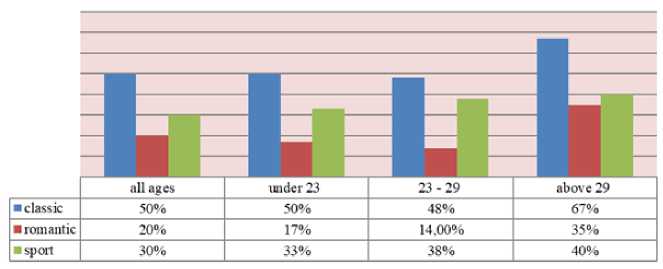
Figure 2. Distribution diagram of responses about clothing style
The results of the question about the silhouette of clothes look interesting. For younger age groups, the silhouette of clothes is not of fundamental importance. As women get older, they tend to wear clothes with a free silhouette (from 37% to 60%). Figure 3 shows a diagram of the results for the clothing silhouette.
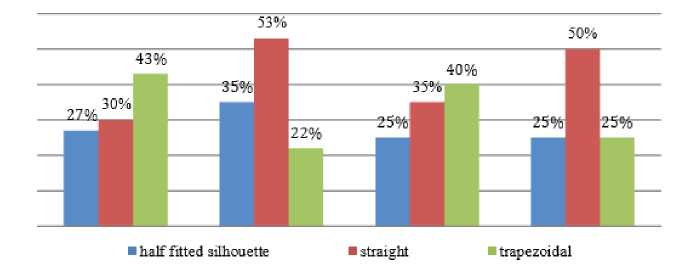
Figure 3. Diagram of results for clothing silhouette
Analyzing consumer preferences regarding the external artistic and structural aspects of clothing, it was found that garments without buttons are highly valued. There are varying opinions on model design, but most consider unadorned clothing to be very appropriate during pregnancy [7]. Therefore, achieving the style of the garment can be done through different colors and fabric textures. Currently, due to modern fashion trends, accessories (30%) are important. Lace detailing, woven straps, and embroidery are seen as secondary features. Regarding the length of women’s clothing, responses were as follows: young mothers wear 'mini' and 'maxi' lengths, while only 46% of older age groups are interested in wearing short dresses. The majority prefer 'midcalf' and 'maxi' lengths (54%). The research results indicate that significant attention is paid to both the clothing and its material [8].
Women's preferences are divided as follows: Comfort of clothing was rated highest, as shown in Figure 4. Durability during washing and maintaining a stylish appearance were also found to be important. However, these two requirements are somewhat contradictory. This is because fabrics made from natural fibers tend to wrinkle quickly and do not maintain their aesthetic appearance.
According to the respondents, clothing should be comfortable to wear, of high quality, and adaptable to a woman's changing figure [9].
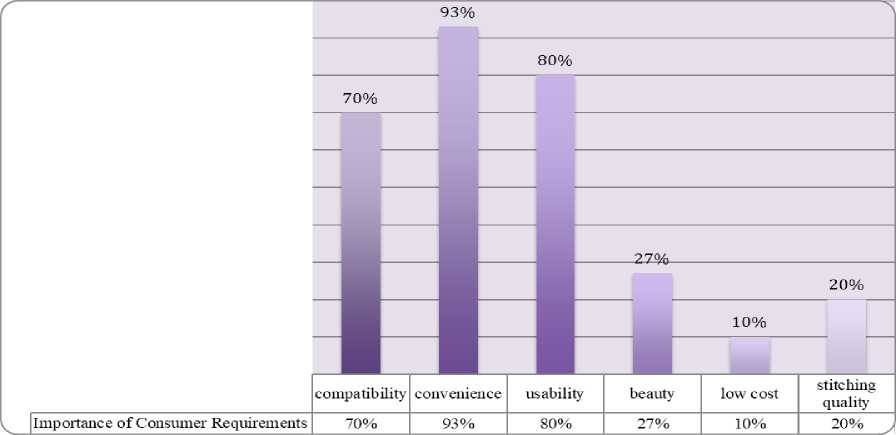
Figure 4. Breakdown diagram of the question about the importance of customer demand
Thus, according to the results of marketing research, the importance of artistic design and the need to consider all consumer requirements when creating an effective wardrobe are emphasized [10].
Results and discussion
A key component in preparing a rational assortment of maternity clothing at the industrial level is determining the parameters of a rational wardrobe for consumers. This requires segmenting the consumer market and creating a systematic structure [11].
Variables considered include age group and stage (seasonal). According to the research findings, the results indicate that the second and third trimesters of pregnancy correspond to specific times of the year when systematizing these variables [12].
Thus, the differences among consumer groups of various age ranges are based on which season their pregnancies coincide with.
Based on the analysis of the conducted research, it is necessary to classify consumers according to their level of satisfaction.
According to the results, seasonal consumers were identified for each age group. This is shown in Figure 5. Thus, the first age group includes those aged 17 to 23, the second group includes those aged 23 to 29, and the third group includes those over 29 [13].
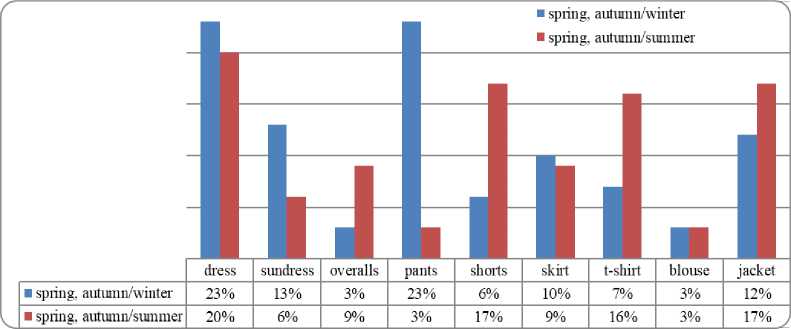
Figure 5. Histogram of the unit number of the rational wardrobe assortment of the younger age group
According to the research, two seasonal types of wardrobes have been identified. The majority of consumers fall into the second age group.
For an organization developing its assortment policy, information about a rational wardrobe structure is important. For an organization that pays attention to each segment of the consumer market (age groups), this is very significant [14].
Conclusion
Thus, the principles considered when designing multifunctional clothing for pregnant women, as well as the artistic-stylistic and structural-technological solutions proposed for the three transformable products characterized by their ability to change appearance and functional purpose, primarily allow for meeting the needs.
Based on market research of consumer preferences, the main artistic and design features of maternity wear have been established. These are considered in the development of constructive-technological solutions.
ПАЙДАЛАНЫЛҒАН ӘДЕБИЕТТЕР ТІЗІМІ
-
1. Андреева, Л. Н. Особенности проектирования одежды для беременных женщин из полимерных материалов с учетом изменения антропометрических параметров фигуры / Л. Н. Андреева, О. Е. Гаврилова, Е. И. Гусева // Вестник Казанского технологического университета. – 2014. – Т. 17, № 11. – С. 88-91. – EDN SHKDID.
-
2. Песцова, А.А. Использование принципов трансформации при проектировании одежды для беременных женщин / А.А. Песцова, И.А. Шеромова//Фундаментальные исследования. -2014. - № 9, Ч. 8.– С. 1677-1681.
-
3. Козлова, Е. В. Разработка конструкций одежды для беременных женщин с учетом срока беременности / Е. В. Козлова, Н. В. Сытник // Швейная промышленность. – 2013. – № 6. – С. 4347. – EDN KVVKHZ.
-
4. Конопальцева, Н.М. Конструирование и технология изготовления одежды из различных материалов: В 2 ч. – Ч. 1. Конструирование одежды: учеб. пособие для вузов / Н.М. Конопальцева, П.И. Рогов, Н.А. Крюкова. – М.: Академия, 2012. – 256 с.
-
5. Тухбатуллина, Л.М. Проектирование костюма / Л.М.Тухбатуллина, Л.А.Сафина, В.В.Хаматова. - Ростов н/Д.: Феникс, 2014. - 283с.
-
6. М.В. Скопич, жүкті Скопич, М.В. Совершенствование методики проектирования одежды для беременных женщин / М.В.Скопич, С.К.Лопандина // Швейная промышленность - № 4. - 2018. - С.43-46.
-
7. Кучарбаева К.Ж., Абдиманапова П.Б., Камалбаева К.К., Жорабекова Г.Ж. Исследование качественных показателей комплектующих материалов для трансформируемого женского платья // Изв. вузов. Технология текстильной промышленности. –2017, №5. – С. 72-75.
-
8. Белова, Н.С. Особенности проектной деятельности студентов вуза при проектировании изделий из полимерных материалов / Н.С. Белова, Л. Л. Никитина // Вестник Казанского технологического университета. -2013. - №24 -С.264-268.
-
9. Шеромова И.А., Нечеса А.А. Принцип проектирования одежды для беременных// Современные проблемы науки и образования. – 2019. – № 6.-C.184-186.
-
10. https://scienceeducation.ru/ru/article/view?id =16836 (дата обращения: 16.02.2023).
-
11. Сильчева, Л. В. Современные подходы к проектированию трансформируемой одежды / Л. В. Сильчева // Сервис в России и за рубежом. – 2014. – № 1(48). – С. 28-39. – EDN RTONMJ.
-
12. Конопальцева Н. М. Конструирование и технология изготовления одежды из различных материалов, Легкая промышленность : [учеб. пособие для вузов : в 2 ч.] / Н. М. Конопальцева, П. И. Рогов, Н. А. Крюкова. - М. : Академия, 2012. -(Высшее профессиональное образование).
-
13. Савостицкий, Н. А. Материаловедение швейного производства : учеб. пособие для сред.
-
14. Сутеева М. А., Кургамбеков М. С. Основы технологии швейного производства. Учебное пособие.- Алматы: TechSmith, 2019. - 208 с.
-
15. Шеромова, И.А Разработка требований к одежде для женщин, ожидающих ребенка / И.А. Шеромова, А.А. Песцова // Инновации и современные технологии в индустрии моды: Материалы Всероссийской научно-практической конференции (12 декабря 2013 г., г. Новосибирск). – Новосибирск: НГАВТ, 2013. – С. 107 - 111.
проф. образования / Н. А. Савостицкий, Э. К. Амирова. - М. : Академия, 2013. - 240 с. - (Среднее профессиональное образование).
Список литературы Research on the preferences of maternity clothing shoppers
- Andreeva, L. N. Osobennosti proektirovaniya odezhdy dlya beremennykh zhenshchin iz polimernykh materialov s uchetom izmeneniya antropometricheskikh parametrov figury / L. N. Andreeva, O. E. Gavrilova, E. I. Guseva // Vestnik Kazanskogo tekhnologicheskogo universiteta. - 2014. - T. 17, № 11. - S. 88-91. - EDN SHKDID.
- Pestsova, A.A. Ispol'zovanie printsipov transformatsii pri proektirovanii odezhdy dlya beremennykh zhenshchin / A.A. Pestsova, I.A. Sheromova//Fundamental'nye issledovaniya. - 2014. - № 9, Ch. 8.- S. 1677-1681.
- Kozlova, E. V. Razrabotka konstruktsii odezhdy dlya beremennykh zhenshchin s uchetom sroka beremennosti / E. V. Kozlova, N. V. Sytnik // Shveinaya promyshlennost'. - 2013. - № 6. - S. 43-47. - EDN KVVKHZ.
- Konopal'tseva, N.M. Konstruirovanie i tekhnologiya izgotovleniya odezhdy iz razlichnykh materialov: V 2 ch. - Ch. 1. Konstruirovanie odezhdy: ucheb. posobie dlya vuzov / N.M. Konopal'tseva, P.I. Rogov, N.A. Kryukova. - M.: Akademiya, 2012. - 256 s.
- Tukhbatullina, L.M. Proektirovanie kostyuma / L.M.Tukhbatullina, L.A.Safina, V.V.Khamatova. - Rostov n/D.: Feniks, 2014. - 283s.
- M.V. Skopich, zhүktі Skopich, M.V. Sovershenstvovanie metodiki proektirovaniya odezhdy dlya beremennykh zhenshchin / M.V.Skopich, S.K.Lopandina // Shveinaya promyshlennost' - № 4. - 2018. - S.43-46.
- Kucharbaeva K.Zh., Abdimanapova P.B., Kamalbaeva K.K., Zhorabekova G.Zh. Issledovanie kachestvennykh pokazatelei komplektuyushchikh materialov dlya transformiruemogo zhenskogo plat'ya // Izv. vuzov. Tekhnologiya tekstil'noi promyshlennosti. -2017, №5. - S. 72-75.
- Belova, N.S. Osobennosti proektnoi deyatel'nosti studentov vuza pri proektirovanii izdelii iz polimernykh materialov / N.S. Belova, L. L. Nikitina // Vestnik Kazanskogo tekhnologicheskogo universiteta. -2013. - №24 - S.264-268.
- Sheromova I.A., Nechesa A.A. Printsip proektirovaniya odezhdy dlya beremennykh// Sovremennye problemy nauki i obrazovaniya. - 2019. - № 6.-C.184-186.
- https://scienceeducation.ru/ru/article/view?id=16836 (data obrashcheniya: 16.02.2023).
- Sil'cheva, L. V. Sovremennye podkhody k proektirovaniyu transformiruemoi odezhdy / L. V. Sil'cheva // Servis v Rossii i za rubezhom. - 2014. - № 1(48). - S. 28-39. - EDN RTONMJ.
- Konopal'tseva N. M. Konstruirovanie i tekhnologiya izgotovleniya odezhdy iz razlichnykh materialov, Legkaya promyshlennost' : [ucheb. posobie dlya vuzov : v 2 ch.] / N. M. Konopal'tseva, P. I. Rogov, N. A. Kryukova. - M. : Akademiya, 2012. - (Vysshee professional'noe obrazovanie).
- Savostitskii, N. A. Materialovedenie shveinogo proizvodstva : ucheb. posobie dlya sred. prof. obrazovaniya / N. A. Savostitskii, E. K. Amirova. - M. : Akademiya, 2013. - 240 s. - (Srednee professional'noe obrazovanie).
- Suteeva M. A., Kurgambekov M. S. Osnovy tekhnologii shveinogo proizvodstva. Uchebnoe posobie.- Almaty: TechSmith, 2019. - 208 s.
- Sheromova, I.A Razrabotka trebovanii k odezhde dlya zhenshchin, ozhidayushchikh rebenka / I.A. Sheromova, A.A. Pestsova // Innovatsii i sovremennye tekhnologii v industrii mody: Materialy Vserossiiskoi nauchno-prakticheskoi konferentsii (12 dekabrya 2013 g., g. Novosibirsk). - Novosibirsk: NGAVT, 2013. - S. 107 - 111.

